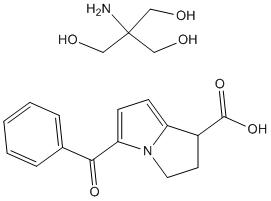
Ketorolac (Toradol) is a non-selective COX inhibitor with IC50 of 31.5 µM and 60.5 µM for human recombinant COX-1 and COX-2, respectively. Ketorolac tromethamine is a non-steroidal anti-inflammatory agent (NSAID) in the family of heterocyclic acetic acid derivative, often used as an analgesic, antipyretic (fever reducer), and anti-inflammatory. Ketorolac tromethamine (Toradol) acts by inhibiting the bodily synthesis of prostaglandins. The primary mechanism of action responsible for ketorolac’s anti-inflammatory, antipyretic and analgesic effects is the inhibition of prostaglandin synthesis by competitive blocking of the enzyme cyclooxygenase (COX).

MedComm (2020). 2023 Sep 20;4(5):e363.
Arachidonic acid metabolism in health and disease
Ketorolac purchased from AbMole
| Cell Experiment | |
|---|---|
| Cell lines | Primary human osteoblasts cell lines |
| Preparation method | Exposing human osteoblasts cells to Ketorolac for 24 hours.Assessing thymidine incorporation by the TopCount Microplate Scintillation and Luminescence Counters through adding [3H]-thymidine to cultures 4 hours prior to harvesting. Using propidium iodide in flow cytometer to determine cell cycle distribution , and using the Annexin V-FITC Apoptosis Detection Kit to detect cell apoptosis or necrosis. |
| Concentrations | Dissolved in DMSO, final concentration ~0.1 mM |
| Incubation time | 24 hours |
| Animal Experiment | |
|---|---|
| Animal models | Male Wistar rats |
| Formulation | Dissolved in DMSO and diluted in saline. |
| Dosages | 0.3-30 mg/kg |
| Administration | Take orally |
| Molecular Weight | 376.4 |
| Formula | C19H24N2O6 |
| CAS Number | 74103-07-4 |
| Solubility (25°C) | DMSO 70 mg/mL |
| Storage |
Powder -20°C 3 years ; 4°C 2 years In solvent -80°C 6 months ; -20°C 1 month |
| Species | Mouse | Rat | Rabbit | Guinea pig | Hamster | Dog |
| Weight (kg) | 0.02 | 0.15 | 1.8 | 0.4 | 0.08 | 10 |
| Body Surface Area (m2) | 0.007 | 0.025 | 0.15 | 0.05 | 0.02 | 0.5 |
| Km factor | 3 | 6 | 12 | 8 | 5 | 20 |
| Animal A (mg/kg) = Animal B (mg/kg) multiplied by | Animal B Km |
| Animal A Km |
For example, to modify the dose of Compound A used for a mouse (20 mg/kg) to a dose based on the BSA for a rat, multiply 20 mg/kg by the Km factor for a mouse and then divide by the Km factor for a rat. This calculation results in a rat equivalent dose for Compound A of 10 mg/kg.
[1] Ewan D McNicol, et al. Ketorolac for postoperative pain in children
[3] Benjamin Maslin, et al. Safety Considerations in the Use of Ketorolac for Postoperative Pain
| Related COX Products |
|---|
| Oxyphenbutazone
Oxyphenbutazone is an orally active non-selective COX inhibitor. Oxyphenbutazone selectively kills non-replicating Mycobaterium tuberculosis. |
| Birch triterpenes
Birch triterpenes is a cyclooxygenase-2 (COX-2) inhibitor that can be used in studies related to epidermolysis bullosa. |
| Naproxcinod
Naproxcinod is a first-of-its-kind (first-in-class) cyclooxygenase-inhibiting nitric oxide donors (CINODs) with analgesic and anti-inflammatory activity for studies related to osteoarthritis and inflammation. |
| Hamaudol
Hamaudol is a chromone isolated from Saposhnikovia divaricata. |
| (±)-Catechin
(±)-Catechin (rel-Cianidanol) is the racemate of Catechin. |


Products are for research use only. Not for human use. We do not sell to patients.
© Copyright 2010-2023 AbMole BioScience. All Rights Reserved.
